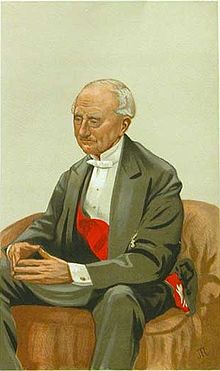Hastings Yelverton
| Sir Hastings Yelverton | |
|---|---|

As depicted by James Tissot in Vanity Fair, June 1877. Caption read "Spanish Ironclads"
|
|
| Born | March 1808 |
| Died | 24 July 1878 Bath, Somerset |
| Allegiance | United Kingdom |
| Service/branch | Royal Navy |
| Years of service | 1823–1877 |
| Rank | Admiral |
| Commands held |
First Naval Lord Mediterranean Fleet Channel Squadron HMS Conqueror HMS Brunswick HMS Arrogant HMS Aigle HMS Queen |
| Battles/wars |
Portuguese Civil War Crimean War Cantonal Revolution |
| Awards | Knight Grand Cross of the Order of the Bath |
Admiral Sir Hastings Reginald Yelverton, GCB (March 1808 – 24 July 1878), born Hastings Reginald Henry, was a Royal Navy officer. As a junior officer he took part in a major action against pirates off Candia in June 1826 and was involved in protecting British interests during the Portuguese Civil War during the early 1830s. He saw action in the Crimean War as Captain of one of the two ships that captured a Russian barque beneath the batteries at Ekenäs in Finland in May 1854. Then in July 1873 he took part in the suppression of the Cantonal Revolution in Cartagena. He became First Naval Lord in September 1876 and in that role implemented a series of economies demanded by the Disraeli ministry but was also involved in ordering the small, cheap and thoroughly unsuccessful ironclad Ajax-class battleships.
Born the son of John Joseph Henry (of Straffan) and Lady Emily Elizabeth FitzGerald (daughter of William FitzGerald, 2nd Duke of Leinster), Hastings Henry, as he then was, entered the Royal Navy as a first-class volunteer aboard the frigate HMS Sybulle in the Mediterranean Fleet in 1823. He took part in a major action against pirates off Candia in June 1826 and subsequently served as a midshipman and mate in the brig HMS Columbine, the frigate HMS Undaunted and then the battleship HMS St Vincent in home waters.
...
Wikipedia
